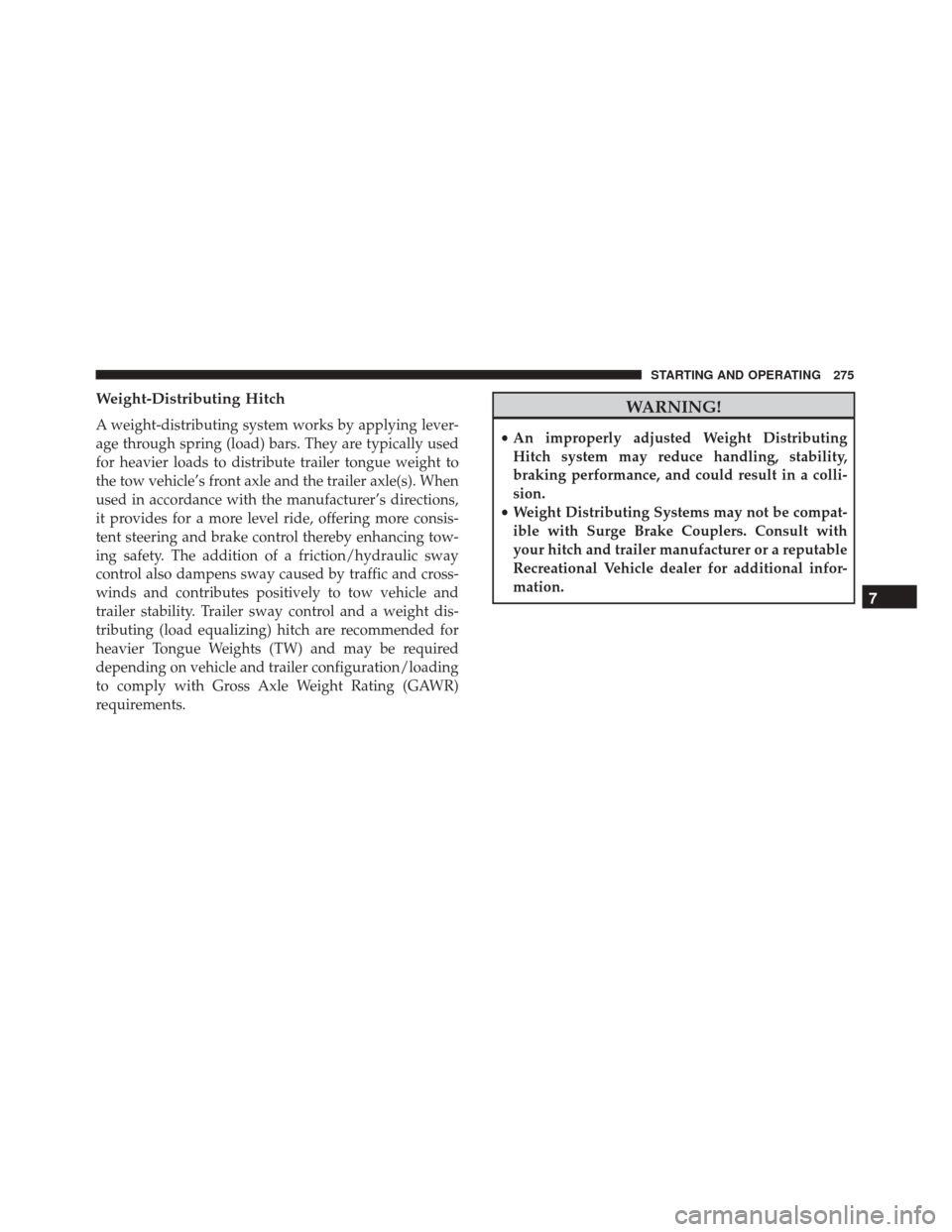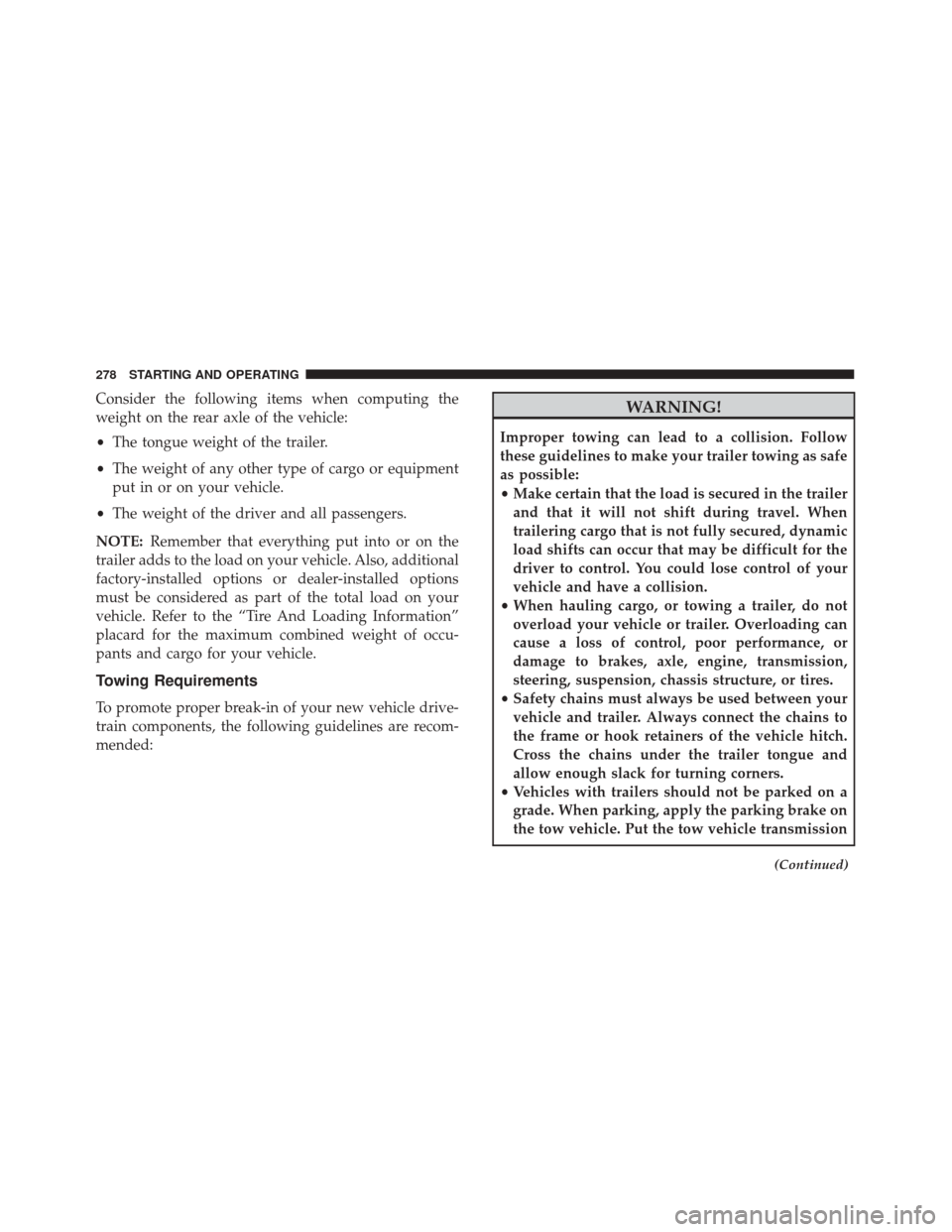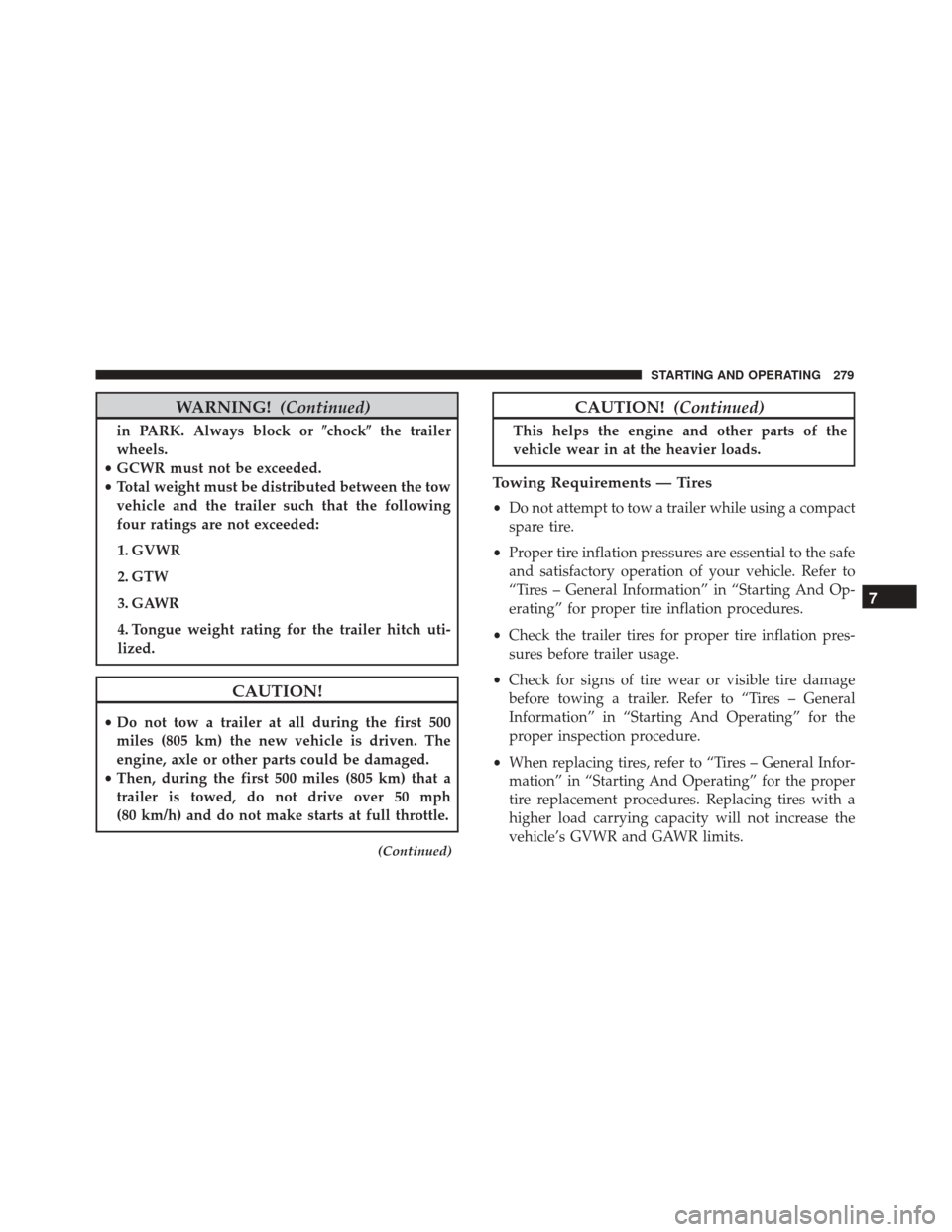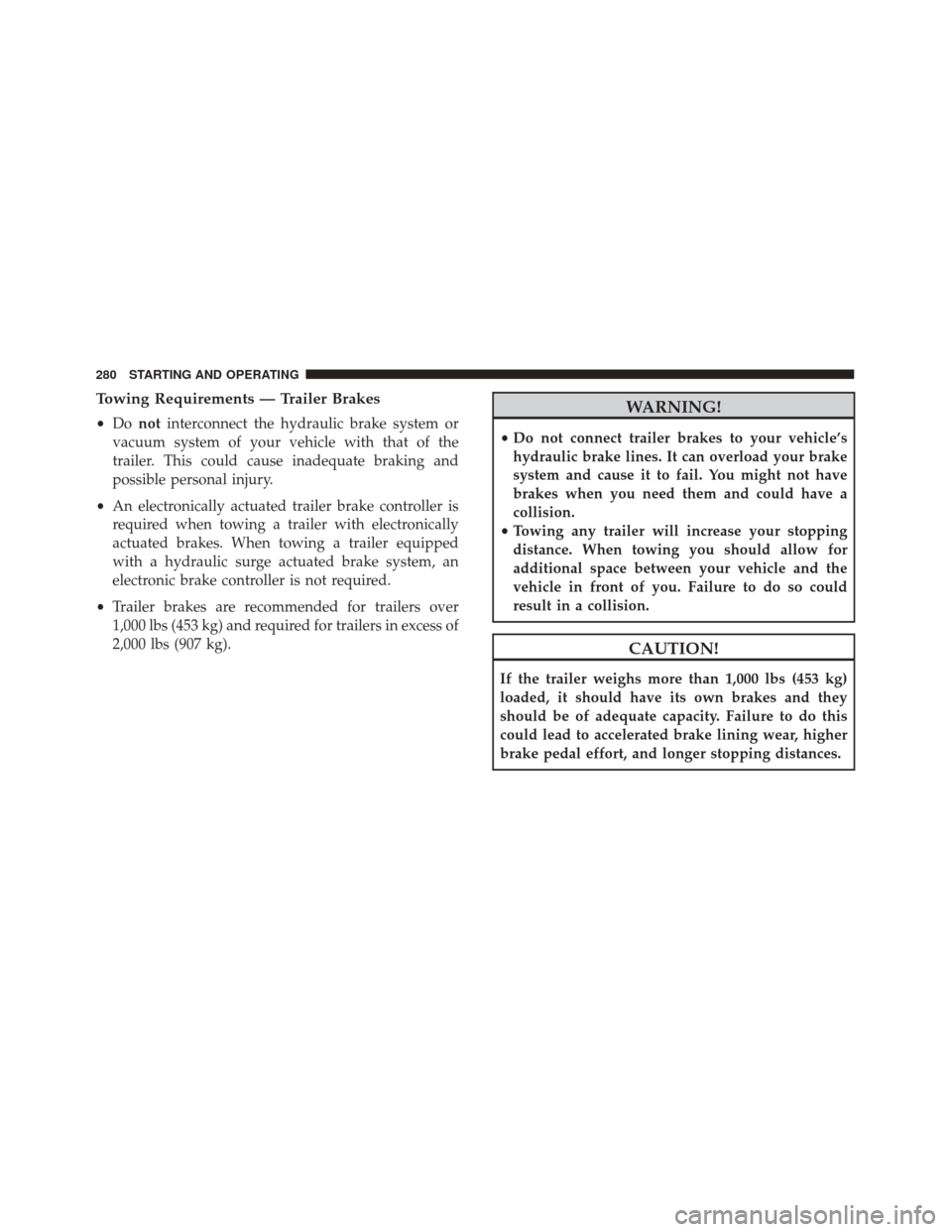Page 277 of 476

Weight-Distributing Hitch
A weight-distributing system works by applying lever-
age through spring (load) bars. They are typically used
for heavier loads to distribute trailer tongue weight to
the tow vehicle’s front axle and the trailer axle(s). When
used in accordance with the manufacturer’s directions,
it provides for a more level ride, offering more consis-
tent steering and brake control thereby enhancing tow-
ing safety. The addition of a friction/hydraulic sway
control also dampens sway caused by traffic and cross-
winds and contributes positively to tow vehicle and
trailer stability. Trailer sway control and a weight dis-
tributing (load equalizing) hitch are recommended for
heavier Tongue Weights (TW) and may be required
depending on vehicle and trailer configuration/loading
to comply with Gross Axle Weight Rating (GAWR)
requirements.
WARNING!
•An improperly adjusted Weight Distributing
Hitch system may reduce handling, stability,
braking performance, and could result in a colli-
sion.
• Weight Distributing Systems may not be compat-
ible with Surge Brake Couplers. Consult with
your hitch and trailer manufacturer or a reputable
Recreational Vehicle dealer for additional infor-
mation.
7
STARTING AND OPERATING 275
Page 280 of 476

Consider the following items when computing the
weight on the rear axle of the vehicle:
•The tongue weight of the trailer.
• The weight of any other type of cargo or equipment
put in or on your vehicle.
• The weight of the driver and all passengers.
NOTE: Remember that everything put into or on the
trailer adds to the load on your vehicle. Also, additional
factory-installed options or dealer-installed options
must be considered as part of the total load on your
vehicle. Refer to the “Tire And Loading Information”
placard for the maximum combined weight of occu-
pants and cargo for your vehicle.
Towing Requirements
To promote proper break-in of your new vehicle drive-
train components, the following guidelines are recom-
mended:
WARNING!
Improper towing can lead to a collision. Follow
these guidelines to make your trailer towing as safe
as possible:
• Make certain that the load is secured in the trailer
and that it will not shift during travel. When
trailering cargo that is not fully secured, dynamic
load shifts can occur that may be difficult for the
driver to control. You could lose control of your
vehicle and have a collision.
• When hauling cargo, or towing a trailer, do not
overload your vehicle or trailer. Overloading can
cause a loss of control, poor performance, or
damage to brakes, axle, engine, transmission,
steering, suspension, chassis structure, or tires.
• Safety chains must always be used between your
vehicle and trailer. Always connect the chains to
the frame or hook retainers of the vehicle hitch.
Cross the chains under the trailer tongue and
allow enough slack for turning corners.
• Vehicles with trailers should not be parked on a
grade. When parking, apply the parking brake on
the tow vehicle. Put the tow vehicle transmission
(Continued)
278 STARTING AND OPERATING
Page 281 of 476

WARNING!(Continued)
in PARK. Always block or �chock�the trailer
wheels.
• GCWR must not be exceeded.
• Total weight must be distributed between the tow
vehicle and the trailer such that the following
four ratings are not exceeded:
1. GVWR
2. GTW
3. GAWR
4. Tongue weight rating for the trailer hitch uti-
lized.
CAUTION!
• Do not tow a trailer at all during the first 500
miles (805 km) the new vehicle is driven. The
engine, axle or other parts could be damaged.
• Then, during the first 500 miles (805 km) that a
trailer is towed, do not drive over 50 mph
(80 km/h) and do not make starts at full throttle.
(Continued)
CAUTION! (Continued)
This helps the engine and other parts of the
vehicle wear in at the heavier loads.
Towing Requirements — Tires
•Do not attempt to tow a trailer while using a compact
spare tire.
• Proper tire inflation pressures are essential to the safe
and satisfactory operation of your vehicle. Refer to
“Tires – General Information” in “Starting And Op-
erating” for proper tire inflation procedures.
• Check the trailer tires for proper tire inflation pres-
sures before trailer usage.
• Check for signs of tire wear or visible tire damage
before towing a trailer. Refer to “Tires – General
Information” in “Starting And Operating” for the
proper inspection procedure.
• When replacing tires, refer to “Tires – General Infor-
mation” in “Starting And Operating” for the proper
tire replacement procedures. Replacing tires with a
higher load carrying capacity will not increase the
vehicle’s GVWR and GAWR limits.
7
STARTING AND OPERATING 279
Page 282 of 476

Towing Requirements — Trailer Brakes
•Do not interconnect the hydraulic brake system or
vacuum system of your vehicle with that of the
trailer. This could cause inadequate braking and
possible personal injury.
• An electronically actuated trailer brake controller is
required when towing a trailer with electronically
actuated brakes. When towing a trailer equipped
with a hydraulic surge actuated brake system, an
electronic brake controller is not required.
• Trailer brakes are recommended for trailers over
1,000 lbs (453 kg) and required for trailers in excess of
2,000 lbs (907 kg).
WARNING!
• Do not connect trailer brakes to your vehicle’s
hydraulic brake lines. It can overload your brake
system and cause it to fail. You might not have
brakes when you need them and could have a
collision.
• Towing any trailer will increase your stopping
distance. When towing you should allow for
additional space between your vehicle and the
vehicle in front of you. Failure to do so could
result in a collision.
CAUTION!
If the trailer weighs more than 1,000 lbs (453 kg)
loaded, it should have its own brakes and they
should be of adequate capacity. Failure to do this
could lead to accelerated brake lining wear, higher
brake pedal effort, and longer stopping distances.
280 STARTING AND OPERATING
Page 289 of 476

IN CASE OF EMERGENCY
CONTENTS
�HAZARD WARNING FLASHERS ..........289
� BULB REPLACEMENT ..................289
▫ General Information ...................289
▫ Replacement Bulbs ...................290
▫ Replacing Exterior Bulbs ...............291
▫ Replacing Interior Bulbs ................300
� FUSES ............................. .305
▫ General Information ...................305
▫ Access To The Fuses ..................307
▫ Engine Compartment Fuses/Distribution
Unit ............................. .307
▫ Body Computer Fuse Center .............312
▫ Rear Cargo Fuse/Relay Distribution Unit. . . .314
� JACKING AND TIRE CHANGING .........315▫
Jack Location/Spare Tire Stowage — If
Equipped ......................... .315
▫ Preparations For Jacking ...............317
▫ Jacking Instructions ..................318
▫ Road Tire Installation ..................322
� TIRE SERVICE KIT STORAGE .............323
▫ Tire Service Kit — If Equipped ..........324
� JUMP STARTING .....................327
▫ Preparations For Jump Start .............327
▫ Jump Starting Procedure ...............328
� REFUELING IN EMERGENCY ............330
� IF YOUR ENGINE OVERHEATS ..........330
� GEAR SELECTOR OVERRIDE ............331
� FREEING
A STUCK VEHICLE ............332
8
Page 291 of 476

HAZARD WARNING FLASHERS
The Hazard Warning flasher switch is located on the
switch bank below the radio.Push the switch to turn on the Hazard Warning
Flasher. When the switch is activated, all direc-
tional turn signals will flash on and off to warn oncom-
ing traffic of an emergency. Push the switch a second
time to turn off the Hazard Warning flashers.
This is an emergency warning system and it should not
be used when the vehicle is in motion. Use it when your
vehicle is disabled and it is creating a safety hazard for
other motorists.
When you must leave the vehicle to seek assistance, the
Hazard Warning flashers will continue to operate even
though the ignition is placed in OFF mode.
NOTE: With extended use the Hazard Warning flashers
may wear down your battery.
BULB REPLACEMENT
General Information
• Before you replace a bulb, check the contacts to be
sure they are not oxidized.
• Replace the bulbs with the same type and wattage.
• After replacing a light bulb, always check the correct
orientation.
• Before replacing a bulb that is not functioning, check
that the fuse is intact.
NOTE: Lens fogging can occur under certain atmo-
spheric conditions. This will usually clear as atmo-
spheric conditions change to allow the condensation to
change back into a vapor. Turning the lamps on will
usually accelerate the clearing process.
8
IN CASE OF EMERGENCY 289
Page 295 of 476
5. Install the headlamp bulb and socket; align the tabsand turn it clockwise making sure it is properly
locked.
WARNING!
Carry out the operation of replacing lamps only
with the engine off. Also make sure that the engine
is cold, to avoid the danger of burns. Position Lights/Daytime Running Lights/Fog Lights
To replace the bulbs proceed as follows:
1. Turn the front wheels completely.
2. Use a suitable tool to remove the access door.
3. Remove the electrical connectors.
Headlamp Bulb Connector
Position Light/Daytime Running Light/Fog light Access
1 — Screws
2 — Access Door
8
IN CASE OF EMERGENCY 293
Page 306 of 476
2. Replace the bulb by removing it from the sidecontacts.
3. Insert the new bulb, locking it between the contacts.
4. Reinstall the dome light.
Interior Cargo Lights
To replace the bulbs proceed as follows:
1. Open the luggage compartment and remove the dome light assembly.
2. Open the light cover and replace the bulb. 3. Close the light cover over the bulb.
4. Reinstall the dome light in its correct position.
WARNING!
•
Before proceeding with the replacement of the
lamp wait for the exhaust pipes are cool: DAN-
GER OF BURNS!
• Modifications or repair of the electrical system
performed incorrectly and without taking into
(Continued)
Bulb
Light Cover
304 IN CASE OF EMERGENCY